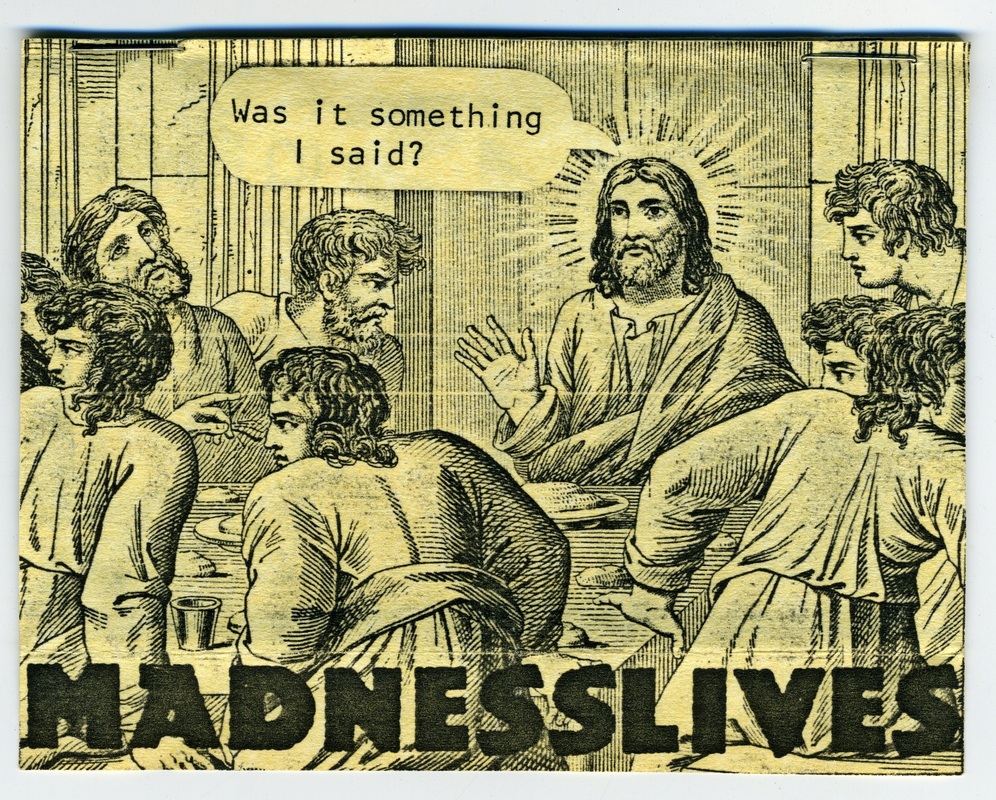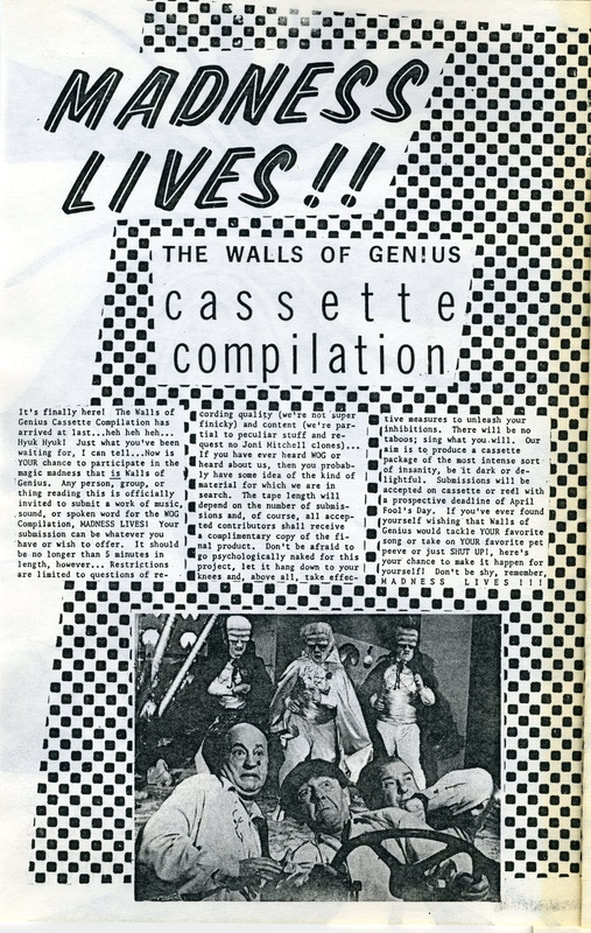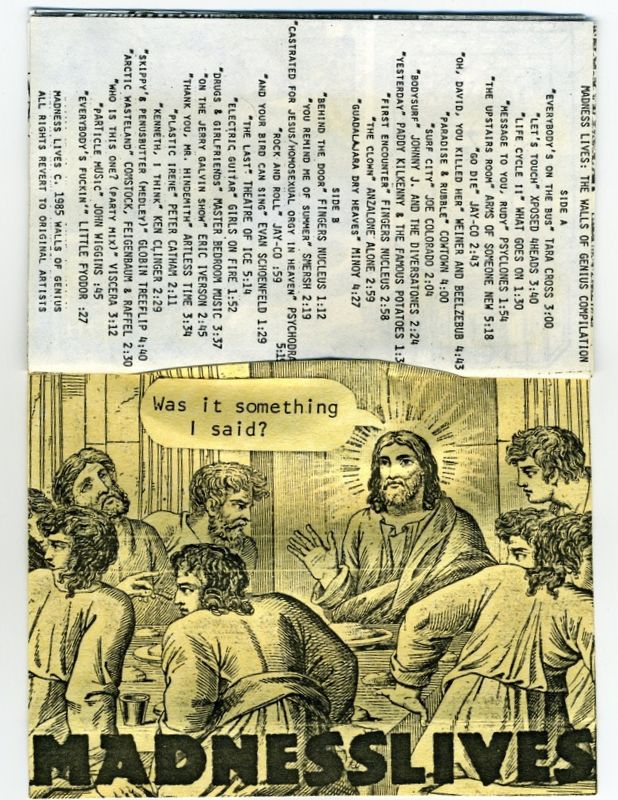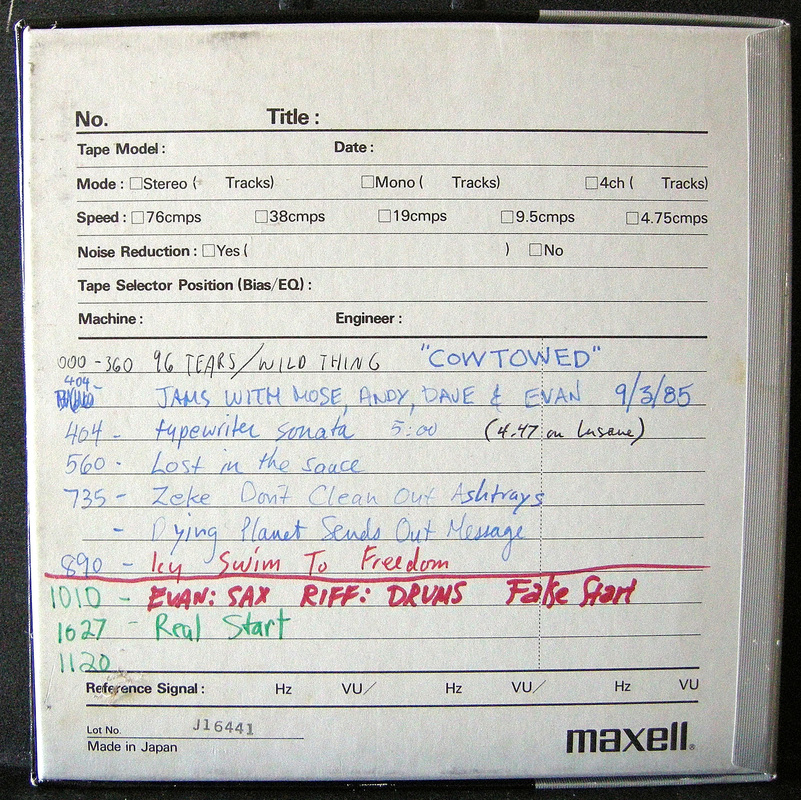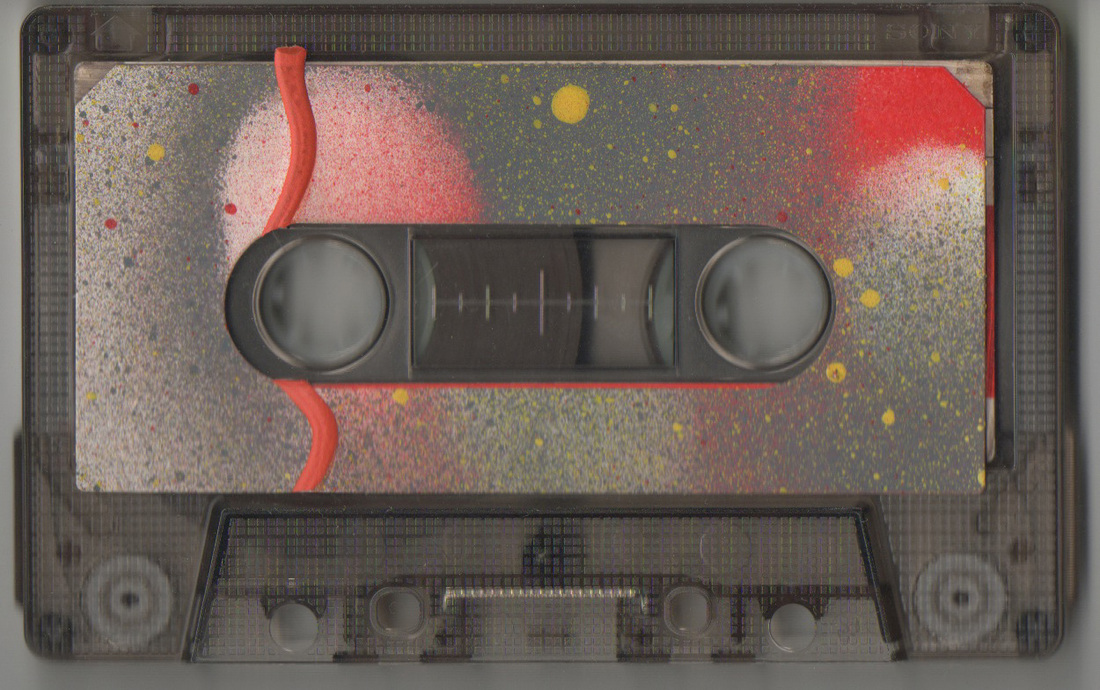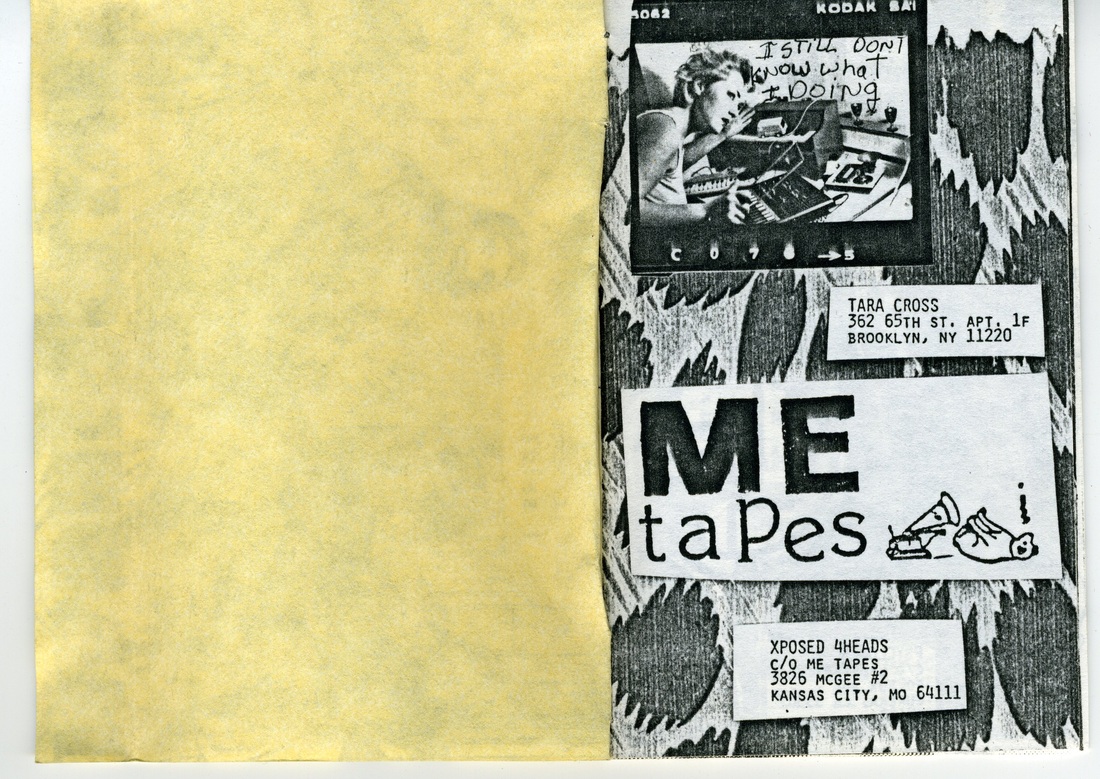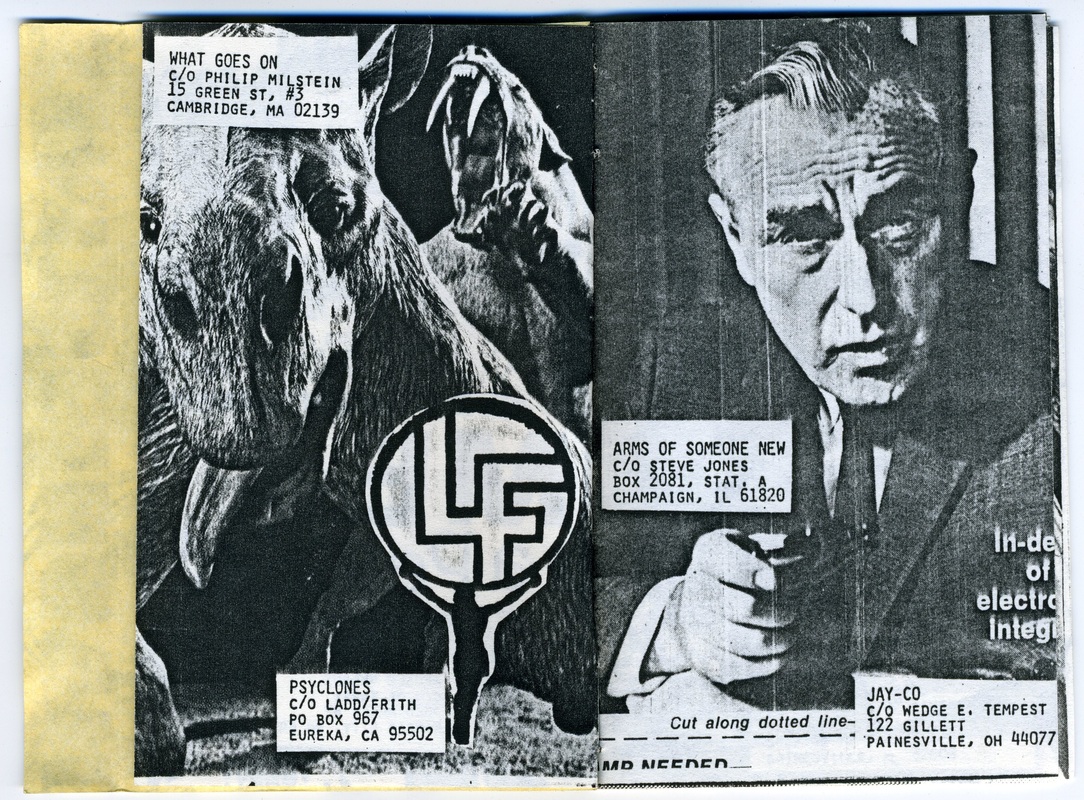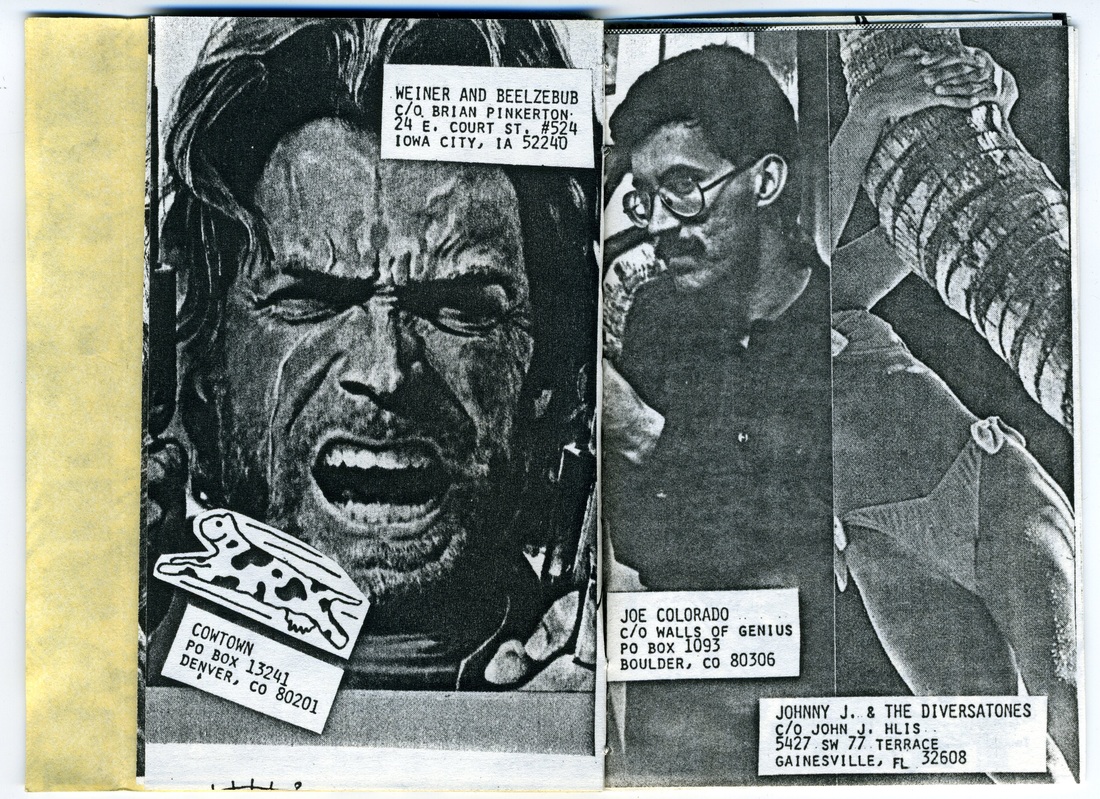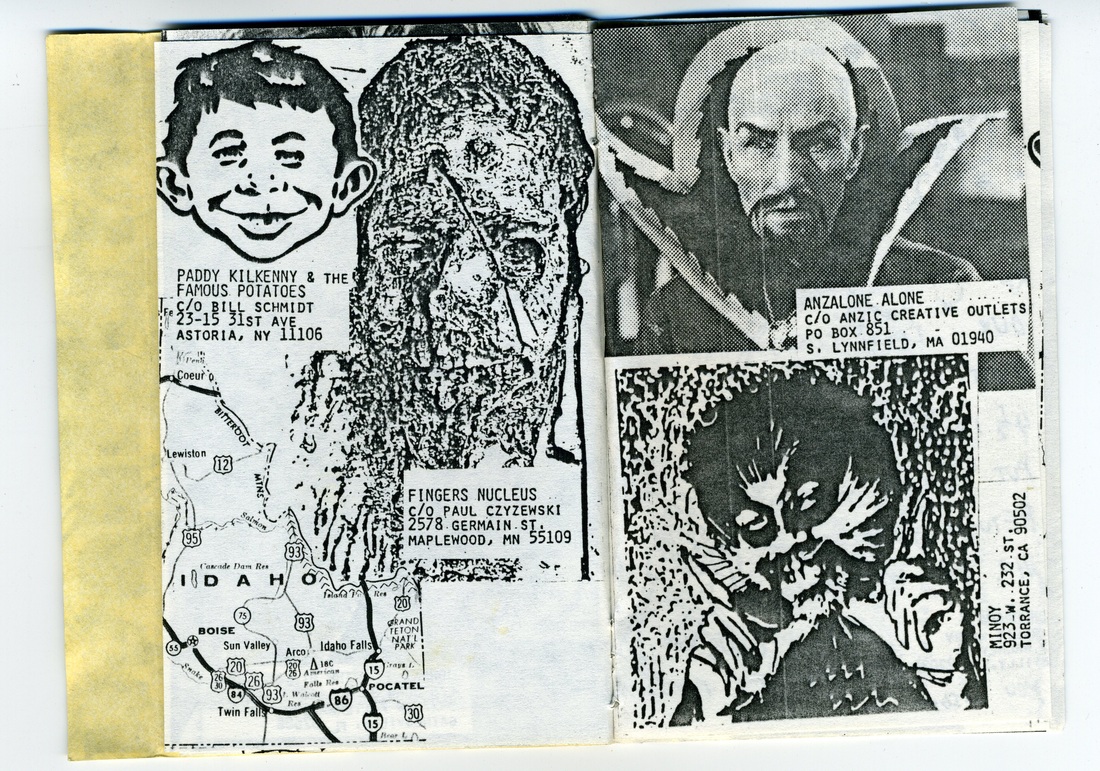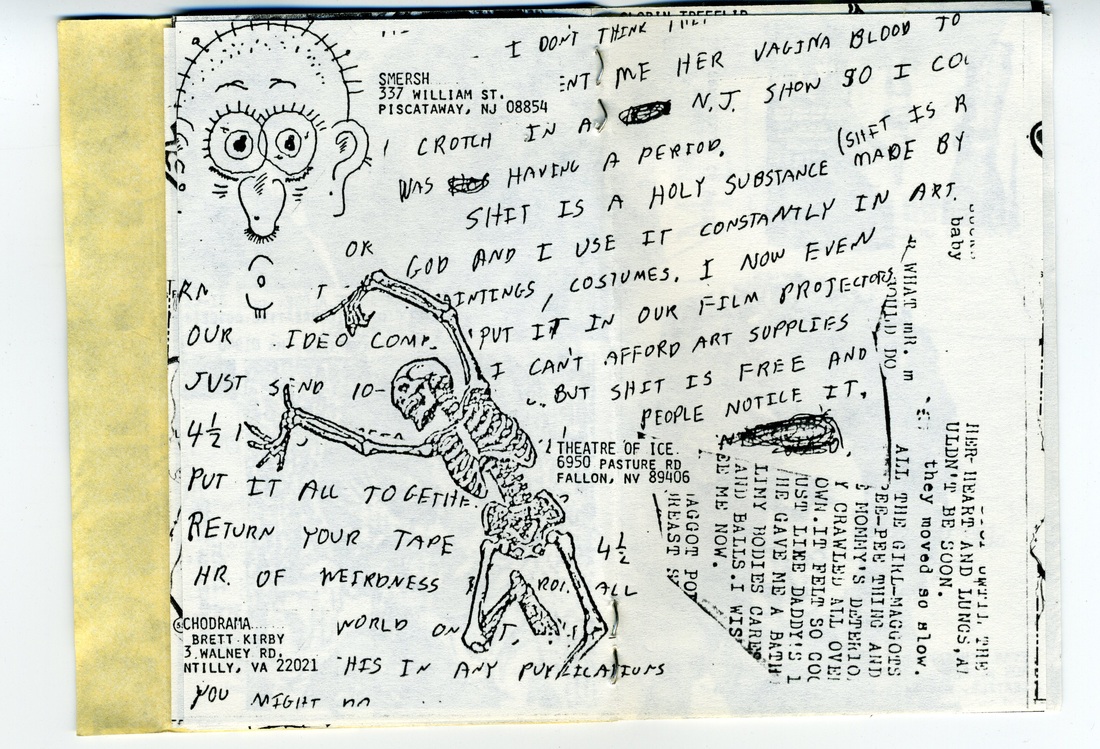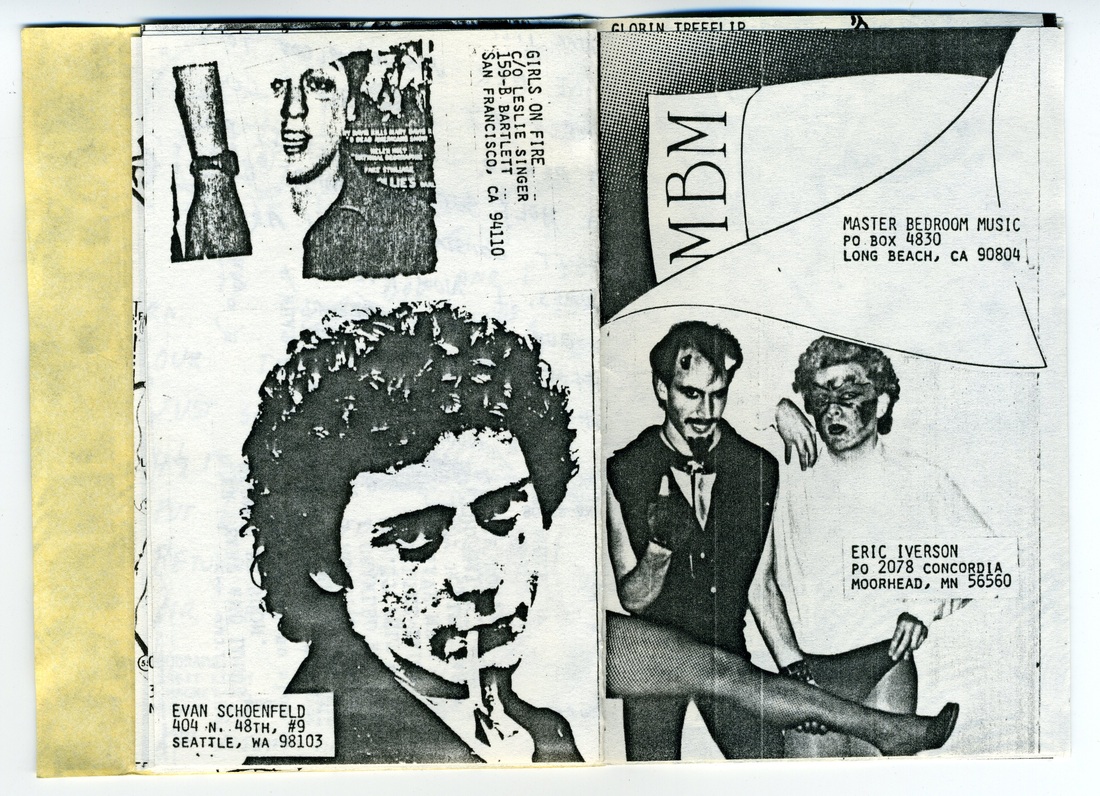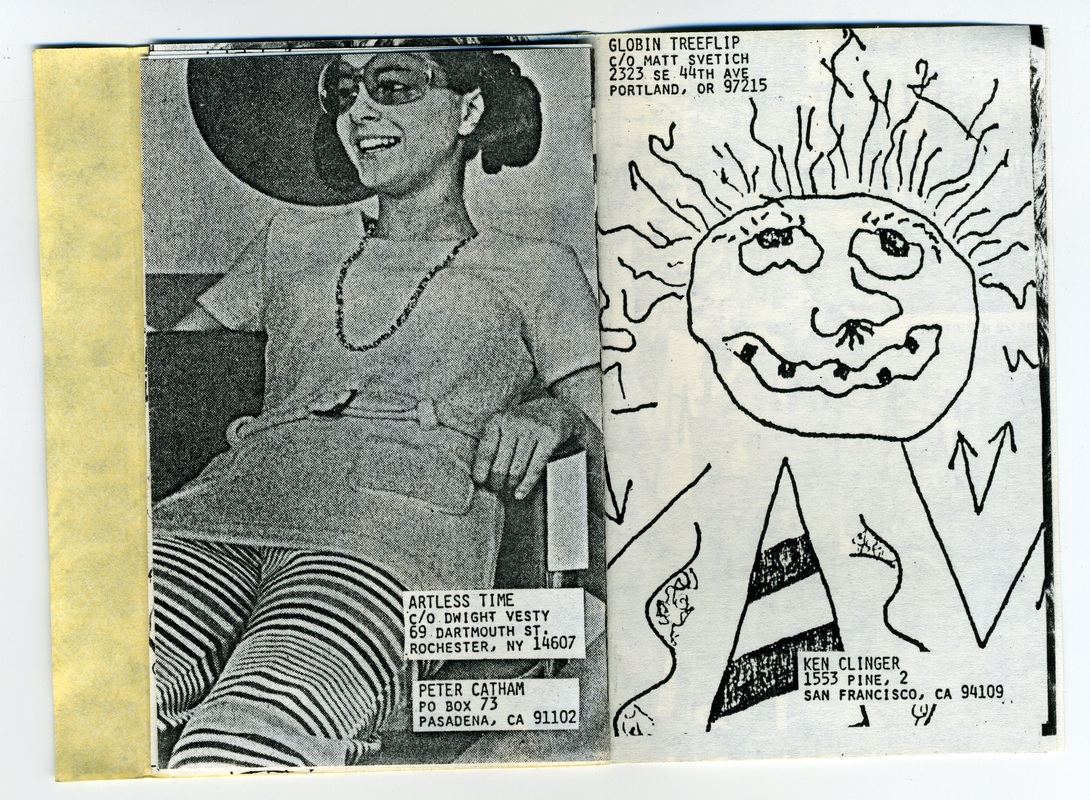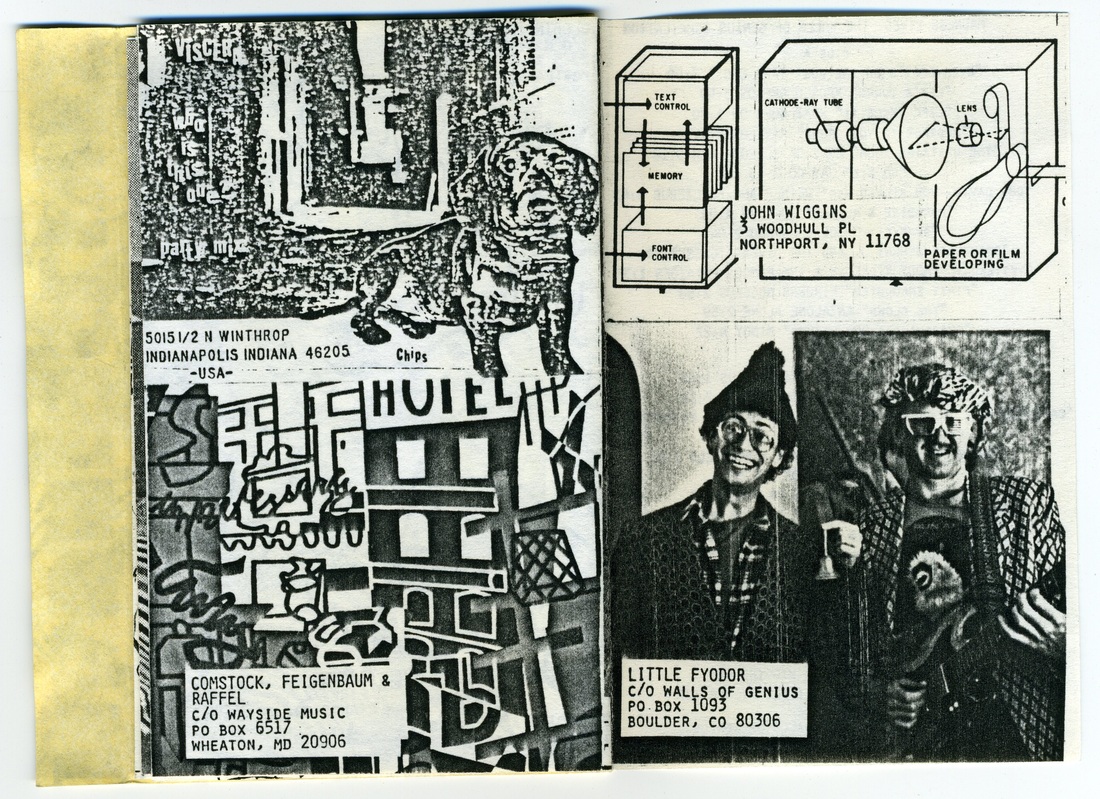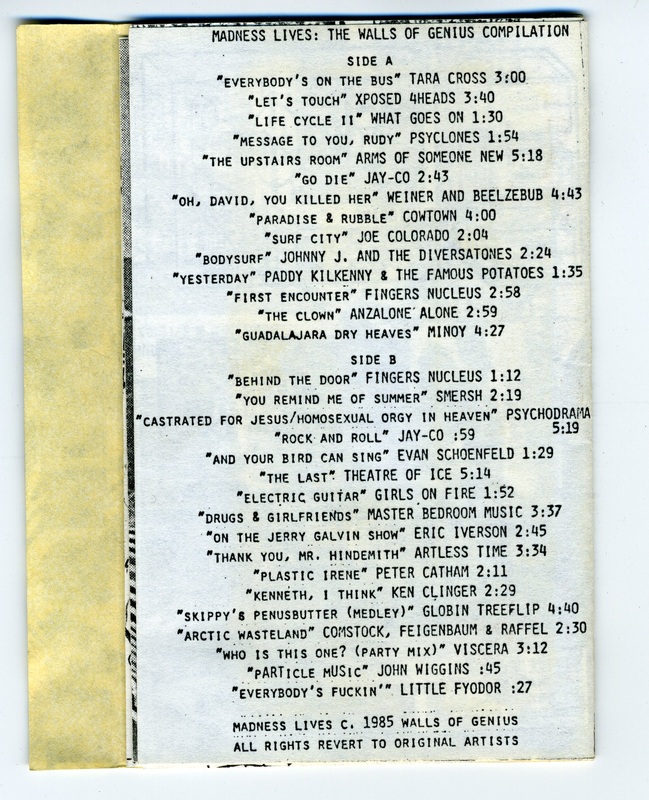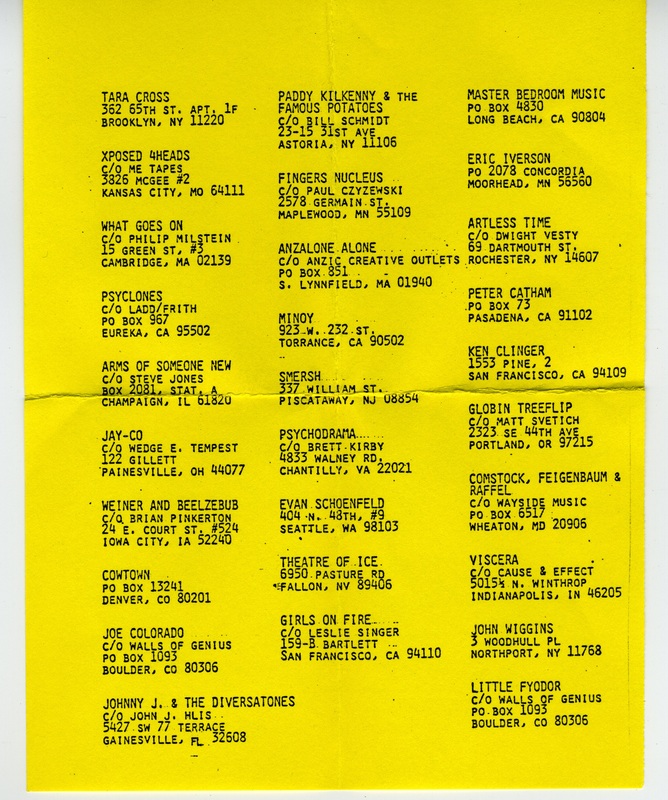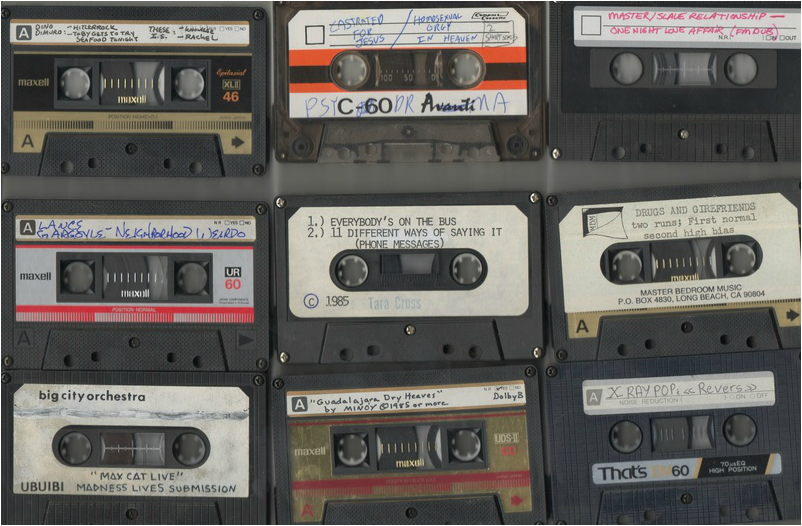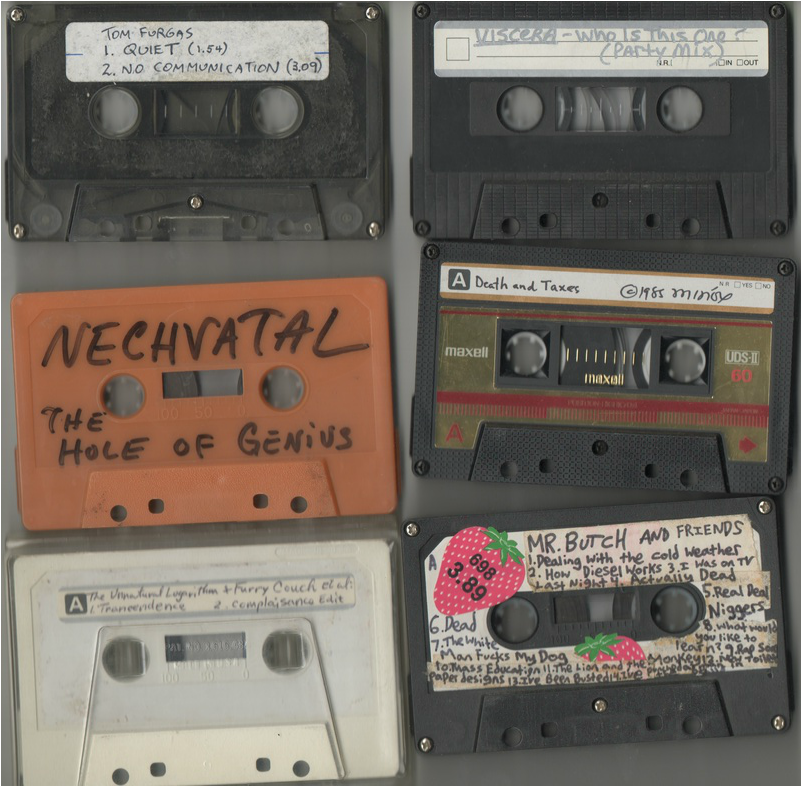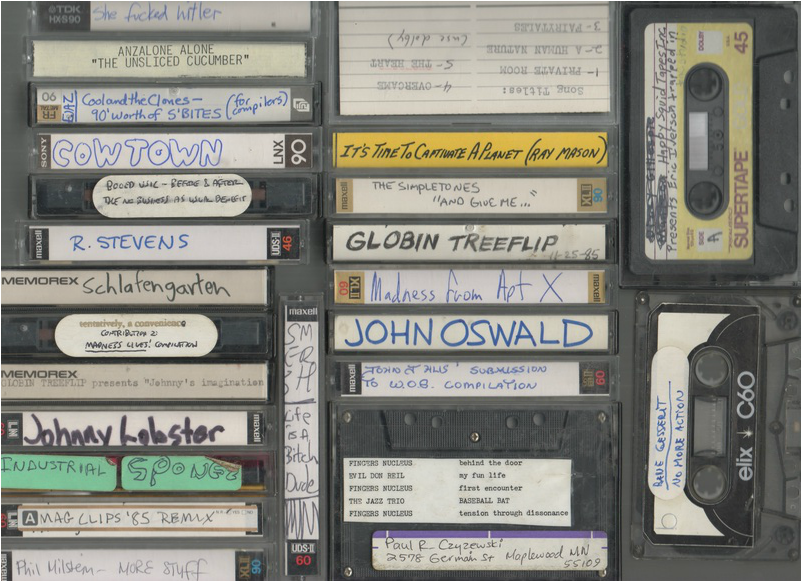WoG 0022 - Madness Lives
|
|
Little Fyodor (David Lichtenberg):
I think the Cassette Underground was a pretty singular event in history. The availability of cheap recording mechanisms meant that everyone was doing it (well not literally everyone, work with me here!), and they were sending it and trading it all over the world (well, mostly the First World, but still). Yet, unlike with the internet, which has made world wide access even more readily available, nothing was virtual, it was all based around tangible objects. Mostly the cassette, of course. But other tangible objects, such as letters and zines, were also important, and people were using these methods to communicate with each other in this very dispersed manner. It was a community of sorts, particularly with regard to the feeling that we were all creating and sharing with like-minded individuals, i.e., people who wanted culture the mass media wasn’t offering and were willing to get it from outside of the normal, typical mass market and mass media means, as well as people who didn’t want to wait for opportunity from the mass music industry to come knocking to create and share their creations with others. One of the common artifacts of cassette culture was the compilation cassette. Just announce that you’re putting out a compilation and the submissions were likely to flow in. Walls Of Genius had already contributed to and appeared on several of these. Now we thought that we had built up enough of a reputation to attract some contributors (not that that was necessarily necessary as we were all exposure whores anyway) and to feel good (that’s the important part!) about putting out a compilation of our own. Evan was especially hoping that we could attract music that tilted towards our own ilk because of the nuances within that same reputation.
Evan Cantor:
By the time we were soliciting submissions to our compilation project, we were in touch with just about anybody who was anybody in the cassette culture. We ended up with 29 items for Madness Lives, two of which, of course, were from Walls Of Genius members Evan Cantor (as Joe Colorado) and David Lichtenberg (as Little Fyodor). A number of compilations had already appeared in this cassette world and we figured we could do just as well or better, especially since we had all these connections and were now “stars” of the underground culture. But we had a ‘theme’ in mind. This would be a “Walls Of Genius” compilation, reflecting something of our own conceptual approach, something that would make it unique and unusual. Not yer average compilation tape, in other words.
LF:
I don’t remember all the details of how we got the word out, but I think our primary means was just an announcement in our catalog. We sent out a few hundred of those out, so a lot of people saw Evan’s spiel in there, which was in our Gift of the Geek catalog. You can read for yourself what Evan said to draw people in and also to steer them towards our interests, including just the name itself, “Madness Lives”. We also let people know through general correspondence, letters and such.
EC:
We solicited the submissions via an invitation in our catalog The Gift Of The Geek. The first page of the catalog described what we were looking for. We didn’t want inoffensive, ambient stuff. Not that there’s anything wrong with that kind of experimental music, but it wasn’t what we were looking for. We wanted the submissions to reflect psychological nakedness. We wanted our participants to let it all hang out, all the way down to their knees, to unleash their inhibitions. We claimed that there would be no taboos (although I’m sure we would have blanched at any truly racist or threatening material, none of which we ever received). Submissions were to be made by cassette via snail-mail and we asked people to limit the length of submissions to no more than five minutes. We ended up with so much material that we felt a second compilation tape was deserved (Son Of Madness).
I think the Cassette Underground was a pretty singular event in history. The availability of cheap recording mechanisms meant that everyone was doing it (well not literally everyone, work with me here!), and they were sending it and trading it all over the world (well, mostly the First World, but still). Yet, unlike with the internet, which has made world wide access even more readily available, nothing was virtual, it was all based around tangible objects. Mostly the cassette, of course. But other tangible objects, such as letters and zines, were also important, and people were using these methods to communicate with each other in this very dispersed manner. It was a community of sorts, particularly with regard to the feeling that we were all creating and sharing with like-minded individuals, i.e., people who wanted culture the mass media wasn’t offering and were willing to get it from outside of the normal, typical mass market and mass media means, as well as people who didn’t want to wait for opportunity from the mass music industry to come knocking to create and share their creations with others. One of the common artifacts of cassette culture was the compilation cassette. Just announce that you’re putting out a compilation and the submissions were likely to flow in. Walls Of Genius had already contributed to and appeared on several of these. Now we thought that we had built up enough of a reputation to attract some contributors (not that that was necessarily necessary as we were all exposure whores anyway) and to feel good (that’s the important part!) about putting out a compilation of our own. Evan was especially hoping that we could attract music that tilted towards our own ilk because of the nuances within that same reputation.
Evan Cantor:
By the time we were soliciting submissions to our compilation project, we were in touch with just about anybody who was anybody in the cassette culture. We ended up with 29 items for Madness Lives, two of which, of course, were from Walls Of Genius members Evan Cantor (as Joe Colorado) and David Lichtenberg (as Little Fyodor). A number of compilations had already appeared in this cassette world and we figured we could do just as well or better, especially since we had all these connections and were now “stars” of the underground culture. But we had a ‘theme’ in mind. This would be a “Walls Of Genius” compilation, reflecting something of our own conceptual approach, something that would make it unique and unusual. Not yer average compilation tape, in other words.
LF:
I don’t remember all the details of how we got the word out, but I think our primary means was just an announcement in our catalog. We sent out a few hundred of those out, so a lot of people saw Evan’s spiel in there, which was in our Gift of the Geek catalog. You can read for yourself what Evan said to draw people in and also to steer them towards our interests, including just the name itself, “Madness Lives”. We also let people know through general correspondence, letters and such.
EC:
We solicited the submissions via an invitation in our catalog The Gift Of The Geek. The first page of the catalog described what we were looking for. We didn’t want inoffensive, ambient stuff. Not that there’s anything wrong with that kind of experimental music, but it wasn’t what we were looking for. We wanted the submissions to reflect psychological nakedness. We wanted our participants to let it all hang out, all the way down to their knees, to unleash their inhibitions. We claimed that there would be no taboos (although I’m sure we would have blanched at any truly racist or threatening material, none of which we ever received). Submissions were to be made by cassette via snail-mail and we asked people to limit the length of submissions to no more than five minutes. We ended up with so much material that we felt a second compilation tape was deserved (Son Of Madness).
Madness Lives compilation announcement on page 2 of the
Walls Of Genius Gift Of The Geek catalog
Walls Of Genius Gift Of The Geek catalog
EC:
The package itself was quite lovely. The cover featured an engraving of Christ at the last supper, fashioned after DaVinci’s famous painting, with a cartoon balloon coming from Jesus, saying “Was it something I said?”. This was something of an on-going joke since I had used the same line for a poetry reading flyer previously. I have no idea where I obtained the engraving, but I was always on the lookout for interesting and useful material. The cover, printed on nice beige paper, was attached to a small booklet with an image from (or provided for) each artist with their name and address for contact. There was also a ¼ page insert with all the names and addresses. The cassette itself had a spray-painted label on the B-side and a label indicating “Walls Of Genius Compilation” and “Madness Lives” and “Side A” on the A-side. The spray-painted labels were made with two colors. I used pebbles with both color applications to block out abstract shapes. The other side was photocopied from a full sheet with the words typed over and over, so I didn’t have to worry about lining them up with the labels. This made it easy to deal with. There were the ubiquitous “Authentic” labels on the cassette box. These labels were the ‘cut-outs’ from spray-painted cassette label sheets. I hated to waste the things, plus it was fun to use these labels as it indicated something special about the ‘hand-made’ nature of the product.
The package itself was quite lovely. The cover featured an engraving of Christ at the last supper, fashioned after DaVinci’s famous painting, with a cartoon balloon coming from Jesus, saying “Was it something I said?”. This was something of an on-going joke since I had used the same line for a poetry reading flyer previously. I have no idea where I obtained the engraving, but I was always on the lookout for interesting and useful material. The cover, printed on nice beige paper, was attached to a small booklet with an image from (or provided for) each artist with their name and address for contact. There was also a ¼ page insert with all the names and addresses. The cassette itself had a spray-painted label on the B-side and a label indicating “Walls Of Genius Compilation” and “Madness Lives” and “Side A” on the A-side. The spray-painted labels were made with two colors. I used pebbles with both color applications to block out abstract shapes. The other side was photocopied from a full sheet with the words typed over and over, so I didn’t have to worry about lining them up with the labels. This made it easy to deal with. There were the ubiquitous “Authentic” labels on the cassette box. These labels were the ‘cut-outs’ from spray-painted cassette label sheets. I hated to waste the things, plus it was fun to use these labels as it indicated something special about the ‘hand-made’ nature of the product.
Madness Lives is available on CDR at Little Fyodor's website.
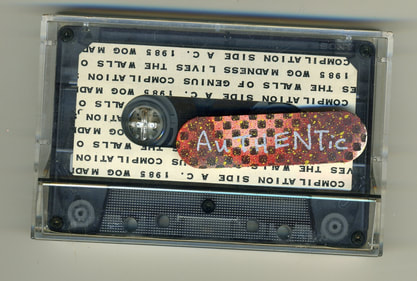
Side A
TARA CROSS - Everybody's On The Bus
XPOSED 4HEADS - Let's Touch
WHAT GOES ON - Life Cycle II
PSYCLONES - Message To You, Rudy
ARMS OF SOMEONE NEW - The Upstairs Room
JAY-CO - Go Die
WEINER AND BEELZEBUB - Oh, David, You Killed Her
COWTOWN - Paradise & Rubble
JOE COLORADO - Surf City
JOHNNY J. AND THE DIVERSATONES - Bodysurf
PADDY KILKENNY & THE FAMOUS POTATOES - Yesterday
FINGERS NUCLEUS - First Encounter
ANZALONE ALONE - The Clown
MINÒY - Guadalajara Dry Heaves
TARA CROSS - Everybody's On The Bus
XPOSED 4HEADS - Let's Touch
WHAT GOES ON - Life Cycle II
PSYCLONES - Message To You, Rudy
ARMS OF SOMEONE NEW - The Upstairs Room
JAY-CO - Go Die
WEINER AND BEELZEBUB - Oh, David, You Killed Her
COWTOWN - Paradise & Rubble
JOE COLORADO - Surf City
JOHNNY J. AND THE DIVERSATONES - Bodysurf
PADDY KILKENNY & THE FAMOUS POTATOES - Yesterday
FINGERS NUCLEUS - First Encounter
ANZALONE ALONE - The Clown
MINÒY - Guadalajara Dry Heaves
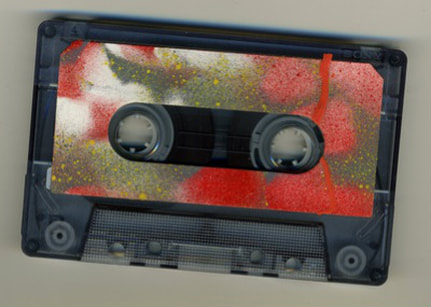
Side B
FINGERS NUCLEUS - Behind The Door
SMERSH - You Remind Me Of Summer
PSYCHODRAMA - Castrated For Jesus /Homosexual Orgy In Heaven
JAY-CO - Rock And Roll
EVAN SCHOENFELD - And Your Bird Can Sing
THEATRE OF ICE - The Last
GIRLS ON FIRE - Electric Guitar
MASTER BEDROOM MUSIC - Drugs & Girlfriends
ERIC IVERSON - On The Jerry Galvin Show
ARTLESS TIME - Than You, Mr. Hindemith
PETER CATHAM - Plastic Irene
KEN CLINGER - Kenneth, I Think
GLOBIN TREEFLIP - Skippy's Penusbutter (Medley)
COMSTOCK, FEIGENBAUM & RAFFEL - Arctic Wasteland
VISCERA - Who Is This One? (Party Mix)
JOHN WIGGINS - Particle Music
LITTLE FYODOR - Everybody's Fuckin'
FINGERS NUCLEUS - Behind The Door
SMERSH - You Remind Me Of Summer
PSYCHODRAMA - Castrated For Jesus /Homosexual Orgy In Heaven
JAY-CO - Rock And Roll
EVAN SCHOENFELD - And Your Bird Can Sing
THEATRE OF ICE - The Last
GIRLS ON FIRE - Electric Guitar
MASTER BEDROOM MUSIC - Drugs & Girlfriends
ERIC IVERSON - On The Jerry Galvin Show
ARTLESS TIME - Than You, Mr. Hindemith
PETER CATHAM - Plastic Irene
KEN CLINGER - Kenneth, I Think
GLOBIN TREEFLIP - Skippy's Penusbutter (Medley)
COMSTOCK, FEIGENBAUM & RAFFEL - Arctic Wasteland
VISCERA - Who Is This One? (Party Mix)
JOHN WIGGINS - Particle Music
LITTLE FYODOR - Everybody's Fuckin'
|
EC:
The booklet included a nice picture of Tara Cross, indicating “I Still Don’t Know What I Doing” . Tara, along with Roberta Eklund, was a kind of sex symbol character in the cassette culture. There’s an actual photograph of me looking serious for Joe Colorado. For Psychodrama, we used their correspondence as a background for the ‘centerfold’ page. It indicates that “Shit is a holy substance made by God and I use it constantly in art”. There is a photo of Leslie Singer (Girls On Fire) and of Evan Schoenfeld. I assumed that the picture of two men in makeup represents Eric Iverson in some way. Little Fyodor is represented by a photo of himself with a cone-head hat, standing next to Ed Fowler, probably taken at Ed’s place on Dahlia Street in Denver. Some of the artists provided material that I could use for the booklet, some did not. In the case of those who did not, I just took images that I thought were interesting or odd and used them. Dubs were made on a pair of Sharp cassette decks, two at a time, in real time. The master cassette was played on a higher-quality Yamaha deck. I had to use the TEAC mixer in order to get 2 stereo lines going simultaneously. For the mixdown to the master cassette, the signal would come from the original submissions, played on one of the Sharps, through a Parasound Graphic Equalizer and a TEAC 6-trac mixer, then out to the master cassette on the Yamaha. For the most part, the challenge was to determine a proper order and then to make sure it fit the side of the tape as closely as possible, since we wanted to avoid “dead air” at the end of the tapes. I had timed all the submissions with a stop-watch. I would typically go about forty minutes into a side without worrying much about it and then try to figure out what I had available that would fit into the remaining slot(s). Since we were not using custom-made cassettes, using commercial 90-minute cassette tapes forced me to always be conscious of the 90-minute length. Sometimes we employed cut-offs to fill the side of a tape, but not for Madness Lives. There’s so much great material on this tape! We never did know who some of these people were. The snail mail trail provided as much anonymity, if desired, as any modern online avatar. There’s no telling how many people saw the catalogs as they may have been shared amongst friends. The Psyclones were friends of ours, Brian Ladd & Julie Frith, who published the Objekt zine and were early enthusiasts of Walls of Genius. By “enthusiast”, I mean anybody who was willing to write about us, whether good or bad or in between. We met them in Eureka at the time of our cancelled gig there (no audience in Eureka, no underground scene beyond Brian & Julie). Others were people and groups we were in friendly contact with: Tara Cross, Xposed 4Heads, Anzalone Alone, Minóy, Fingers Nucleus, Psychodrama, Evan Schoenfeld, Girls On Fire, Master Bedroom Music, Ken Clinger, Viscera, John Wiggins. Evan Schoenfeld once sent me cassettes of the Holy Modal Rounders and Mott The Hoople after we expressed mutual admiration for those groups. He was impressed that the Rounders were especially “WoG-like” in their uninhibited singing. We met Leslie Singer (who was Girls On Fire and had made a video rubbing a fish over her naked body) when we played a gig in San Francisco, organized by William Davenport of Unsound magazine. Psychodrama took such a radical approach (anybody remember the ‘shoving of the yams’?) that we weren’t sure there wasn’t fecal matter on their submitted material. One of our favorite submissions, “Yesterday” by Paddy Kilkenny, remains a mystery to this day. Who was Paddy Kilkenny? Smersh was a group that had actually made some records (not on any mainstream label, of course) and I still occasionally play a song of mine that was partly inspired by one of theirs (“When Judy eats lunch, Judy goes crunch”). There were, of course, submissions from myself and David. I did one of my trademark Surf homage/parodies, “Surf City”, taking off from where “I Live For The Sun” started (on Before… And After). David offered an alternate version of “Everybody’s Fuckin’” (on The Mysterious Case of Pussy Lust). I think he had made something like sixteen different versions, experimenting with what might work best. Cowtown was the conceptual project of Peter Tonks, whom we first met when he had the punk-rock show on KGNU radio Boulder, "Over The Edge". “Cowtown” was a put-down nick-name for Denver. In the 80s, this was the “old” Denver. With a tip of the hat to the time-honored animus that seems to have always existed between Denver and Boulder, including amongst experimental musicians, we were ourselves a bit Boulder-centric. In those days, we felt like there was more going on in Boulder than in Denver. Because of the university, Boulder had a higher concentration of young people. Denver was a bigger town, but it only had one block of bars and nightclubs at that time (Larimer Square). There were endless miles of abandoned warehouses in the railyards district, where underground events sometimes occurred in a sort of clandestine manner (Gerechtigeits Liga & Einsturzende Neubauten, for example). Denver has certainly changed over the years, but in those days, it really did seem like a “cow town”. Peter Tonks lived in this "old" Denver. He was a kindred spirit, via punk-rock and experimental music. I found him to be an 'angry young man' and it wouldn't be far from the truth to call myself the same thing at that time. You can see from the reel tapes that Peter recorded with Walls Of Genius at the Hall of Genius on the Labor Day Weekend in August/September of 1985. One of those tracks is indicated by David’s handwriting (“96 Tears”) and mine (“Cowtowed”). We recorded a great deal of material over those few days. One of the pieces we recorded was a version of “Rainy Day Women” that would appear on the second Madness compilation tape, essentially Walls of Genius with Peter Tonks as lead singer. After this experience, I had a step-by-step falling-out with Peter. Later, I would publish a letter to the editor in Westword, signed by Roy Watkins, from Mud Flats, Wyoming, accusing Peter of the mistaken belief that he was a “somebody who mattered” in Denver. When Peter called me on the letter, I vociferously denied writing it and claimed that somebody who had listened to the ‘Go For It’ program on KGNU (where I sometimes appeared as "Roy Watkins") must have written the letter and had appropriated the Watkins name. Peter was obviously smart enough to know that I was telling a fat one and that was the last time we ever spoke to one another. In any case, Peter was a talented and creative individual and the Cowtown material was certainly worthy. Clearly, I was mistaken, as Peter is definitely "somebody who mattered" in Denver and still does to this day. |
LF:
I’m very proud of the resulting collection, for the high quality of the material on it but especially for the wide variety of styles and persona represented (and lest we forget, variety was one of WoG’s specialties as well as wackiness or what have you). It ranged stylistically from the sensual mock macho rock out of Xposed 4Heads to the cold, arty ethereal jazz of Comstock, Feigenbaum & Raffel (the middle name of which belonged to a fellow who had sent us one of our the rejection letters quoted in an early catalog!); from the goofy polka pop of Master Bedroom Music to the abstract noise of John Wiggins and Minóy (though the latter included media snippets plus vomiting that turned the “noise” into cultural commentary); from the carefully technically adept artistry of Arms of Someone New to the stark, anarchic ravings of Psychodrama, etc. It also featured some of the bigger fish and stalwarts from our little fishbowl of a scene, such as Smersh and Psyclones and Viscera and Girls On Fire (Leslie Singer) and Ken Clinger and Theatre Of Ice, but it also included a number of outstanding contributions from people who were obscure even by Cassette Underground standards, including a few we literally never heard of before or since they sent their submission tape to us. Like Jay-Co. Jay-Co sent us one tape with several outstanding pieces, two of which we used on this tape and one more we used for Son Of Madness, just because they were so good. And who was Jay-Co? The lead singer sounds like he must have been something like ten or twelve years old, and the accompanying guitar and drums sounded equally, blissfully immature. These kids gave a snarling but joyous middle finger to the adult world that contained more genuine punk rock chutzpah than anything by the likes of the Ramones or the Sex Pistols, even if their sloppy bashing could never have been mass-marketed in like fashion. And “Go Die” even starts out with a nice little sound collage (from a spinning radio dial?) before the brazen guitar and drums crash in. But we never heard of Jay-Co before or after, either in any of the zines or even via direct correspondence. Just nada. They may not have even sent any correspondence with their submission tape, or if they did I bet it was very minimal. I certainly don’t remember anything close to any sort of explanation of the curious and remarkable contents. Ditto for Weiner and Beezlebub, who contributed the brilliant and hilarious movie soundtrack cutup, “Oh, David, You Killed Her”. Actually, I think we (or Evan) may have named this ourselves, as I think it was just part of a longer and continuous collection of material that had no particular track divisions or titles. Evan probably had to edit the part we liked the most to form what we presented as an individual piece. I think the beeps at the end just transitioned straight into more stuff, without there being any definitive ending or delineation between what’s on our comp and what came right afterwards. I don’t know if we tried to contact Mr. Weiner, it may have seemed too much trouble even as there was too little to go by in what was sent to us to concretely determine what he considered to be a separate track or not. We just used our own judgement and, like I said, Evan edited our favorite section and probably named it too…. Other obscure artists included Paddy Kilkenny & the Famous Potatoes, who did a wonderfully messed up send up of “Yesterday”, and Fingers Nucleus, who did a bunch of messed up originals. I don’t think we really ever heard of these guys before or after in the usual underground avenues either, but we at least did maintain a little bit of a correspondence with them such that their existence didn’t seem quite so mysterious and surreal. I think Anzalone Alone, whose clownish existential tale of alienated and Casio founded woe I especially appreciated, had previously sent me a tape to play on my radio show. Same with Evan Schoenfeld, who subsequently became a pretty good pen pal of Evan’s (Evans unite!). So did Globin Treeflip, who later sent me a neat digital Little Fyodor portrait. Or was that Eric Iverson? Well, a bunch of us became pals, even if I don’t remember all the details these 28 years later! I bought a seven inch record by Artless Time once so I thought they were big stars so I was surprised when they contributed to our little ol’ comp. Cowtown was the vehicle of one Peter Tonks, a local (Denver based) fellow with whom we became friends for a while, a former KGNU deejay who’d hosted a legendary punk rock show called Over The Edge but who had been kicked off the air, rumor had it, for his acerbic tongue and rule breaking, primarily over a weekend tinged with station politics (Peter claimed he was railroaded for opinions he expressed on the air and agitated, ultimately successfully, for reinstatement, though leaving the station again a few years later, again amidst some controversy…). I was always impressed with his intense voice and almost demonic presence, behind whichever mike, and Evan liked “Paradise & Rubble” because it reminded him of The Byrds. Cowtown was essentially Peter along with a variable cast, which was to include us for a little while, a little later…. (And then I played with him again for a few years subsequent to WoG's original demise in both Cowtown and the Miracle!) Most people sent us unique pieces just for the comp, which of course was what we liked the best, but we didn’t specify unreleased material as a requirement and some people just sent entire releases and allowed us to pick something off them, or maybe they sent us previously released material but in a form unique to their submission, like Peter Catham, who may have been the only one to send us his submission on a little reel to reel tape, though I believe he had already released his submission on his own cassette release. And then there was also Joe Colorado doing a cover of “Surf City” and yet another “Everybody’s Fuckin’” (this time missing the “g”, which it’s true I probably didn’t sing) from Little Fyodor. It was not uncommon for those putting out a compilation to put themselves on it, and Evan and I did so under our favorite personal aliases in something of a throwback to WoG tradition. “Surf City” was yet another surf sendup by Evan and I believe he played all the instruments, once again playing his acoustic(s?) so rhythmically one doesn’t miss drums. (We then maintained the surf theme a little longer by segueing into “Bodysurf” by Johnny J. and the Diversatones.) “Everybody’s Fuckin’” was yet another of the original 21 takes I did on the day I originally recorded it onto a cassette deck. Including another take that saw release on my later solo album, Idiots Are Closer To God, six of those 21 have seen release (I also recorded two new versions for that solo album, one with Ed on lead guitar!). Evan worked hard to put together the booklet. He used art that seemed to correspond to the artists whose addresses were shown on a given page, using stuff from the artists themselves whenever possible (sometimes even stuff that had been sent with submission), and then just coming up with whatever whenever not. Apologies to those for whom I didn’t come up with something to say. I love everything on this compilation and I think it’s an extraordinary representation and cross section of the cassette scene at the time, albeit from our (happily- and proudly-) warped and skewed point of view…. (Yeah I know everyone thinks that about their own compilation, but I still do anyway, so there!) Side B of The Madness Lives cassette from
Little Fyodor's collection. |
Above: Original cassette submissions by contributors to the Madness compilations,
from the collection of Little Fyodor.
from the collection of Little Fyodor.
